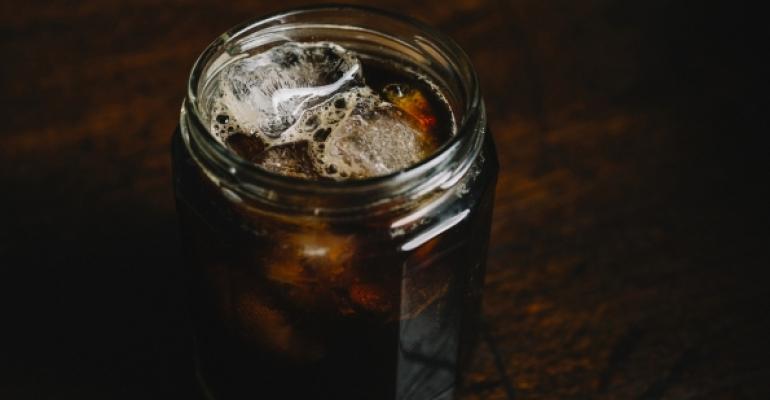While the very phrase “cold brew coffee” appears loaded with contradictions, what’s unquestionable is the buzz it’s generating among coffee drinkers.
According to research published in 2015 by Chicago-based Mintel, retail sales of ready-to-drink cold brew coffee grew 115 percent over 2014, and a staggering 339 percent since 2010. And though Mintel found cold brew claims just a 0.4 percent share of the overall ready-to-drink coffee segment, it’s become a headline grabber in beverage magazines and an increasingly popular choice among millennials.
Although independent coffee shops have been adding cold brew to their menus for several years, more recently they have been joined by coffee brewing behemoths like Starbucks and Dunkin’ Donuts. The former began selling cold brew on a large scale in 2015, while the latter added it this year. Jeff Miller, executive chef and vice president of product innovation at Dunkin’ Brands, says the Canton,Massachusetts-based chain has worked on a cold brew line extension for some time.
“We started testing cold brew in select markets in Massachusetts and Maine earlier this year,” Miller says. “We expanded our test to Metro New York and California in June before launching nationally on August 1.”
The talk now among coffee roasters and shop owners is that the cold brew trend is only just heating up. And as tradespeople, including their restaurant counterparts, learn to make, store and serve it, its popularity should spread quickly.
To make cold brew, coffee beans are ground coarsely, steeped in room temperature water for 12 to 24 hours, filtered and chilled. (It can be steeped in a refrigerator, but since water’s viscosity increases when chilled, flavor extraction from the beans slows markedly.) Baristas commonly start batches the day before and allow them to steep overnight.
The result is a highly flavorful, full-bodied and smooth drink that’s far less acidic than brewed coffee. Some cold brew fans say it’s so smooth that they can forgo sweetener or cream commonly used to soften the bitterness found in hot coffee.
Yet to achieve that desired cold brew flavor, at least three times more coffee is required than in hot brewing. For cold brew, some experts set the ratio of coffee to water at 4 grams of water for every 1 gram of ground coffee. By comparison, brewed coffee is optimal when 15 grams of water is used for every 1 gram of coffee.
Stored refrigerated, cold brew coffee will keep for as long as a week without flavor deterioration. Plus it’s always cold and ready to serve when customers want it. Storage issues can be a problem when producing large volumes of cold brew. More coffee must be kept in dry inventory, and ready-made cold brew consumes space in reach-ins and walk-ins.
To alleviate some space concerns, cold brew veterans recommend making super concentrated batches which can be watered down to the correct strength at service time.
Though cold brew is easy to produce, dozens of bottled products are available as well. Seeing the opportunity to do the work for other coffee shops and restaurants, Stumptown Coffee in Portland, Oregon, began bottling its cold brew in 2011. Diane Aylsworth, the company’s vice president of cold brew, says Stumptown sells bottled cold brews at its 10 coffee shops across the country and to thousands of restaurant and retail accounts.
In 2013 the company began experimenting with kegged coffee pushed on tap using pure nitrogen. (Pushing coffee with CO² creates carbonic acid, which impacts flavor negatively.) A staffer with food science and brewing experience was inspired by what nitrogen did to Guinness Stout, and he wanted to see how it would affect coffee.
“He saw that it created this creamy texture on the palate, that beautiful cascading action in the glass and that thick, creamy head like Guinness,” Aylsworth recalls. “But what really surprised us was that the nitro changed the flavor to something sweeter. And with that you didn’t really need to add any sugar.”
As kegging cold brew took off in independent coffee shops, Stumptown moved to bottle its own version. And ever the trend matcher, Starbucks began conducting a 500-store test of kegged cold brew this year.
According to Aylsworth, pairing cold brew and nitro has led Stumptown “to reimagine our coffee shops.” When it opened its first Southern outpost in New Orleans in April, its centerpiece wasn’t a gleaming espresso machine, it was a seven-head beer draft tower that pushed espresso shots with nitrogen.
“We call that a Cold Shot, and it’s an interesting take on a cold shot of espresso,” she says.
In a demitasse, customers get a 2-ounce shot of cold brew espresso that’s mild, low in acid and creamy.
“The cool thing about using nitro is that it emulates espresso with the crema on top,” she says. “So it’s perfect for us to have afternoon happy hours where people come in to have a Cold Shot. [Cold brew] has really inspired us to rethink our coffee shops.”





